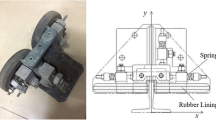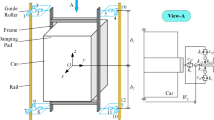Abstract
This study presents a non-linear constitutive equation for the rolling guide-shoes associated with a high-speed elevator system. This was done to accurately evaluate the dynamic behavior of a high-speed elevator car and analyze the action mechanism of random factors during manufacturing and installation on the dispersion of vibration acceleration. Through the combination of the Hertz contact theory and the Bouc-Wen hysteretic model, the non-linear vibration model of the elevator car system was founded. This model was equivalent to a linear system by least squares technique, and then the random parameters and the random excitation were converted by random perturbation method and pseudo excitation method. The acceleration response sensitivities of each random parameters, the means and standard deviations of transverse vibration acceleration responses at the observation point were obtained. In the case, the transverse vibration acceleration responses of the car system were calculated. The elevator car’s vibration instance was analyzed under the different degrees of variation of the random parameters and the random excitation. The results showed that the randomness of geometric parameters has the greatest influence on transverse acceleration. The variability of parameters affects the dispersion degree of the transverse vibration responses while the variability of the excitation mainly affects the amplitude of the vibration response. This study provides an effective method for the analysis of non-linear compound random vibration responses of high-speed elevator car system, and provides a reference for the vibration control design and safety assessment.
Similar content being viewed by others
References
Y. H. Feng, J. W. Zhang and Y. E. Zhao, Modeling and robust control of horizontal vibrations for high-speed elevator, Journal of Vibration & Control, 15 (9) (2009) 1375–1396.
Y. Bao and H. L. Li, Finite-element-based dynamical analysis on high-speed elevator car frame, Chinese Journal of Construction Machinery, 12 (2) (2014) 127–131.
C. C. Chang, C. C. Lin, W. C. Su and Y. P. Huang, H∞ direct output feedback control of high-speed elevator systems, Proceedings of the ASME 2011 Pressure Vessels & Piping Division Conference, USA (2011) 289–296.
I. Herrera, H. Su and S. Kaczmarczyk, Influence of the load occupancy ratio on the dynamic response of an elevator car system, Applied Mechanics and Materials, 706 (2015) 128–136.
W. Hoon, Y. K. Yoon, J. Haeil and G. N. Lee, Nonlinear rate-dependent stick-slip phenomena: modeling and parameter estimation, International Journal of Solids and Structures, 38 (8) (2011) 1415–1431.
Q. Zhang, F. Y. Shi and J. X. Liu, Study on the frequency response functions of structures with uncertain physical parameters, Journal of Vibration and Shock, 25 (2) (2006) 64–66.
Y. L. Xu, Y. Qian, J. J. Chen and G. Song, Stochastic dynamic characteristics of FGM beams with random material properties, Composite Structures, 133 (2015) 585–594.
K. Marcin and S. Marta, Optimization of the truss-type structures using the generalized perturbation-based stochastic finite element method, Finite Elements in Analysis & Design, 63 (1) (2013) 69–79.
R. Lasota, R. Stocki, P. Tauzowski and T. Szolc, Polynomial chaos expansion method in estimating probability distribution of rotor-shaft dynamic responses, Bulletin of the Polish Academy of Science-technical Sciences, 63 (2) (2015) 413–422.
X. X. Hu, B. B. Song, X. X. Dai and X. Liu, Research of gear contact based on Hertz contact theory, Journal of Zhejiang University of Technology, 44 (1) (2016) 19–22.
P. H. Shen and S. W. Lin, Polynomial expression derived from Bouc-Wen hysteretic model and its practical application, Journal of Mechanical Strength, 31 (6) (2009) 360–364.
L. F. Guo, Research on measurement and modeling of rail irregularity of elevator and horizontal vibration characteristics of car cage, Doctoral Thesis, Tianjin University, China (2005).
M. Kamiński and R. L. Ossowski, Prediction of the effective parameters of the nanofluids using the generalized stochastic perturbation method, Physica A: Statistical Mechanics and its Applications, 393 (2014) 10–22.
K. Marcin, Generalized stochastic perturbation technique in engineering computations, Mathematical and Computer Modelling, 51 (3–4) (2010) 272–285.
M. M. Kamiński and J. Szafran, Random eigenvibrations of elastic structures by the response function method and the generalized stochastic perturbation technique, Archives of Civil and Mechanical Engineering, 9 (4) (2009) 5–32.
F. Wu and W. X. Zhong, A hybrid approach for the time domain analysis of linear stochastic structures, Computer Methods in Applied Mechanics and Engineering, 265 (2013) 71–82.
B. Zhao, Y. Q. Wang, Z. H. Chen, Y. J. Shi, Y. Jiang and Y. H. Wang, Research on the random seismic response analysis for multi-and large-span structures to multi-support excitations, Earthquake Engineering and Engineering Vibration, 14 (3) (2015) 527–538.
Q. Wu and D. P. Li, Analysis on pseudo excitation of random vibration for structure of time flight counter, Chinese Journal of Mechanical Engineering, 28 (2) (2015) 325–330.
H. T. Li, Q. B. Wang, Z. Zong, L. Sun and H. Liang, Stochastic hydroelastic analysis of a very large floating structure using pseudo-excitation method, Applied Ocean Research, 48 (2014) 202–213.
Y. Liu, L. Y. Chen and H. Yi, Equivalent stochastic linearization for nonlinear uncertain structure under stationary Gaussian stochastic excitation, Journal of Shanghai Jiaotong University (Science), 19 (1) (2014) 123–128.
Y. F. Wang, S. J. Wang and L. H. Huang, Random vibration analysis for impellers of centrifugal compressors through the pseudo-excitation method, International Journal of Computational Methods, 12 (4) (2015) 1540002-1-16.
R. J. Zhang, X. X. Si, W. W. Yang and M. X. Dong, Resonance reliability sensitivity for a high-speeding elevator cabin system with random parameters, Journal of Vibration and Shock, 34 (6) (2015) 84–88.
Author information
Authors and Affiliations
Corresponding author
Additional information
Recommended by Associate Editor Kyoung-Su Park
Rui-jun Zhang received his Ph.D. in School of Automation from Beijing University of Posts and Telecommunications, China in 2015. Dr. Zhang is currently a Professor in School of Mechanical and Electrical Engineering at Shandong Jianzhu University in Ji’nan, China. His current research topics are elevator dynamics and elevator vibration control.
Rights and permissions
About this article
Cite this article
Zhang, R., Wang, C., Zhang, Q. et al. Response analysis of non-linear compound random vibration of a high-speed elevator. J Mech Sci Technol 33, 51–63 (2019). https://doi.org/10.1007/s12206-018-1206-5
Received:
Revised:
Accepted:
Published:
Issue Date:
DOI: https://doi.org/10.1007/s12206-018-1206-5




